Advertisement
The Ocean Race is among the most difficult challenges in all of sports — a grueling bluewater test of the best and toughest sailors sprinting around the planet in sailboats that can reach 44 mph.
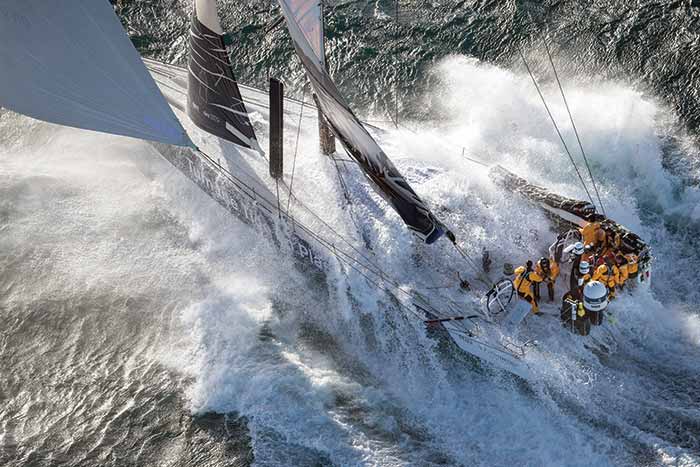
Photo: Ainhoa Sanchez/Volvo Ocean Race
When it comes to sailors, you have your wandering vagabonds, your traditional Corinthian yachtsmen, and your average weekend warriors. And then there are the around-the-world racers, a separate breed of athlete altogether. In the realm of boats, titles such as "The Everest of Sailing" belongs to the Ocean Race, which concluded in late June with what is essentially a photo finish.
Formerly known as the Whitbread Round the World Race (1973–2001) and the Volvo Ocean Race (2002–2021), the Ocean Race is a full-throttle eight-month, 11-leg sprint 45,000 nautical miles around the planet by international crews racing on identical boats. It's a competition to reveal which team has the most skill, and more importantly, which has learned best not only to harness the wind, but to strategize with nature and the sea and integrate their deep knowledge of weather, wind shifts, and currents — to win.
Final Overall Standings
1. Dongfeng Race Team: China
2. MAPFRE: Spain
3. Team Brunel: Netherlands
4. Team AkzoNobel: Netherlands
5. Vestas 11th Hour Racing: USA/Denmark
6. Sun Hung Kai Scallywag: Hong Kong
7. Turn the Tide on Plastic: United Nations
The fact that the latest version of the global race that's held every three years concluded with the closest finish in race history speaks to the high level of competition. Before the final leg, a 970-mile sprint from Gothenburg, Sweden, across the North Sea to the finish at The Hague, Netherlands, three boats were tied atop the leaderboard. The first to finish this last leg would win. After three days of hard sailing, a scant 16 minutes separated Dongfeng Racing Team (China) from second-place finisher AkzoNobel (Netherlands), and 17 minutes from MAPRE (Spain).
Dongfeng skipper Charles Caudrelier of France and his crew made a daring call to take a coastal route to the finish, which squeezed them tight against the shoreline, separate from the other leaders.
"We knew that we would fall behind initially," Caudrelier said. The wind didn't come in on the day they'd hoped for, and the strategy looked as though it had backfired. During their last position report, a frustrated Caudrelier learned they were 27 miles from the finish but still lagging 7 miles behind the leaders. "We thought it was over," he said, but he figured and refigured his weather routing and noticed the wind begin to fill in. "So, I woke everyone up and said, 'Let's push!'" They won the leg and the Volvo.
Fun Facts From The Everest Of Sailing
- The Ocean 65 by Farr Yacht Design in the U.S. has an 18-foot beam, but weighs only 27,500 pounds due to its light carbon-fiber honeycomb construction — about one-third the weight of a Jeanneau 64 fast cruising sailboat.
- Leading up to this latest race, 126 women had competed since its 1973 founding, including 11 in the first edition — in contrast to more than 2,000 men.
- Each leg has a race village that included a full boat shop and repair facility, with professional sailmakers, so all the teams had access to equal shore support.
- Carbon fiber is black, making the boats belowdecks very dark. Brightening up the interior with a coat of lighter color paint might sound like a bright idea. But paint weighs too much, according to the competitive skippers, and none of them did it. So, instead, each boat was required to have white plastic panels of the exact same dimensions affixed along the hull at the location of each pipe berth, to reflect light below for the crew.
- The sailors each consume between 5,000 and 7,000 calories per day but still lose between 11 and 17 pounds per leg given the physical demands of keeping a sailboat going as fast as possible 24/7.
- Weather information is given to the boats every day by the race committee. Independent weather routers are not allowed; all navigation and weather analysis must be done onboard.
- The Ocean 65 can sail at a blazing 38 knots. During the race, the AkzoNobel team beat a race-record for 24-hour sailing — 601 nautical miles across the North Sea, averaging 25 knots.
- Each team includes an onboard journalist who's not allowed to participate in the sailing. Some crews, we heard, convinced their onboard journalist that washing dishes was not only allowed, but expected. Reportedly, the journalists caught on to that ruse by leg two.
- Six American sailors competed in the race, which featured an international cast of sailors representing 43 countries. The carbon-fiber mast stands 98 feet above deck. Each boat carried eight sails and one storm jib. Each team could use a total of 16 sails throughout the race.
- Sail repairs were nonstop during the layovers, and sailmakers were not told whose sails they were working on. But eventually they could tell when the sails were Dongfeng's. "They were always the most chafed and needed the most work," said one sailmaker. The next Volvo Ocean Race starts in the fall 2021 (after the 2021 America's Cup). No host cities or route has been announced yet. TheOceanRace.com
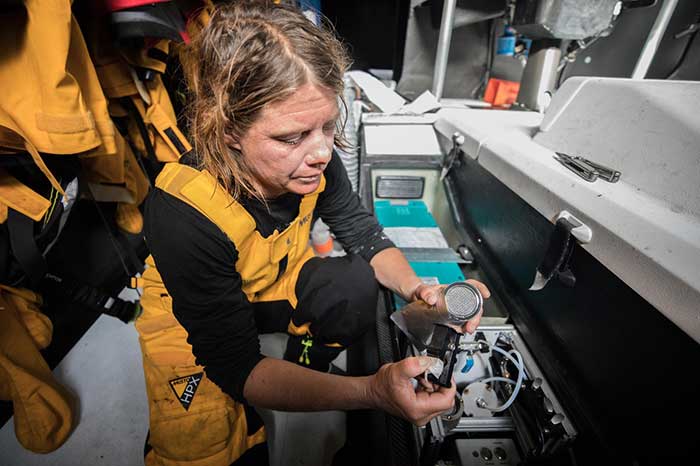
Several of the boats collected water samples throughout the race, which was later analyzed by the GEOMAR Institute for Ocean Research Kiel in Germany. Almost all the water samples contained microplastics. (Photo: Jeremy Lecaudey/Volvo Ocean Race)
Last Sailor Standing
The Ocean Race is not for the faint of heart, with crew cramped in austere quarters among piles of damp clothes and foul-weather gear, sleeping in four-hour shifts and, to reduce weight, no fresh food is taken on board, so freeze-dried is the only thing on the menu. Crews experience temperature variations from 23 F to 104 F and take only one change of clothes. The sailors say they often don't get more than three to four hours of sleep per day.
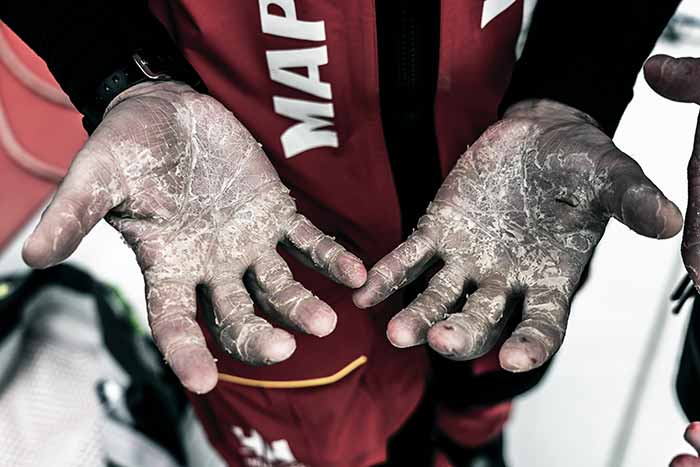
Ocean racing is not for faint of heart. (Photo: Ugo Fonolla/Volvo Ocean Race)
"But four hours off isn't really four hours off. It's just a question of how much can you delay injuries, tiredness, and fatigue along the way," Chris Nicholson, an Australian watch captain aboard AkzoNobel, told Business Insider magazine. The most dangerous times on board are not when surfing big waves. Instead, they come if (and probably when) your thoroughbred boat with canting keel, twin daggerboards, and twin fixed rudders gets damaged, which forces the skipper to slow down. "When you have to slow down, that's when you're at the mercy of the next waves breaking in over you."
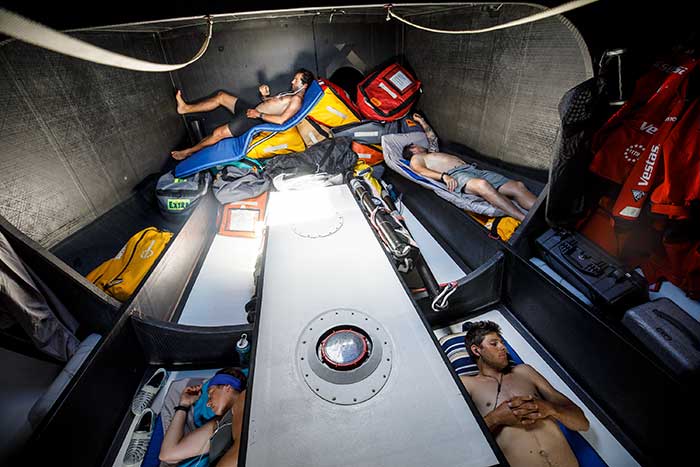
Vestas 11th Hour Racing crewmembers get some shuteye when they can — usually no more than three to four hours a day. (Photo: Avery Ross/Volvo Ocean Race)
Beyond hard work, the race poses real-world dangers. In March, Team Sun Kai/Scallywag crew John Fisher of Britain was swept overboard in gale-force conditions 1,400-miles west of Cape Horn, Africa. Intense rescue efforts failed, and he was lost at sea. In January, Vestas 11th Hour Racing collided at night with a Chinese fishing vessel. Nine of the 10 commercial fishermen were rescued from the water. One lost his life.
The Fiberglass Ceiling
Rule changes for the 2017–18 race limited the crew to a maximum of seven. However, to encourage the male-dominated teams to open up to more female competitors, a new rule allowed for two additional crew, bringing the total onboard to nine, as long as those two were women. Not all teams embraced the idea, preferring to go with seven strong men and not take on the additional weight of two women crew and the extra food and supplies. But by the middle of the race, all seven teams had realized that the women were an advantage and added female sailors to their crew. A total of 20 women competed in this year's race. British sailor Dee Caffari was the skipper of Turn the Tide on Plastic. Dongfeng crew Carolijn Brouwer of the Netherlands, France's Marie Riou, and Swiss sailor Justine Mettraux, became the first women to win the epic race.
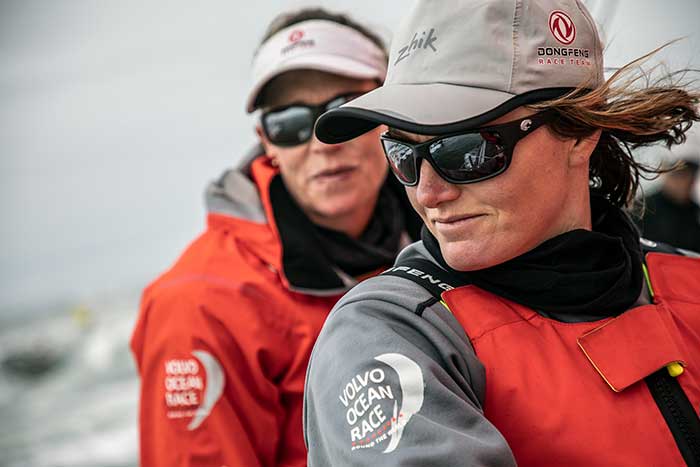
Rule changes encouraged more female competitors in this year’s race, like Dongfeng's Marie Riou. (Photo: Avery Ross/Volvo Ocean Race)
Tip
"The intensity of the competition, the manic schedule in port, the stripped-down simplicity of life at sea, the nonstop every-waking-hour concentration is both daunting and addictive," Caffari's Irish crewmember Annalise Murphy posted on her blog.
Murphy is now switching her focus to mastering the 49erFX skiff with teammate Katie Tingle as they set their sights on competing in the 2020 Summer Olympics in Tokyo. Racing sailors have to keep moving, keep sailing, keep looking over the horizon for the next challenge.
